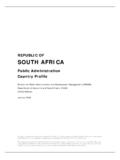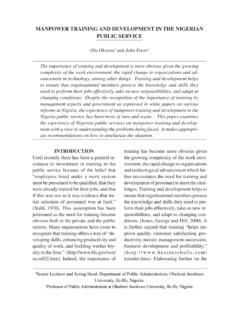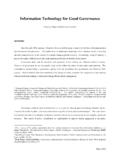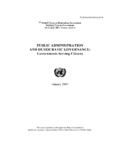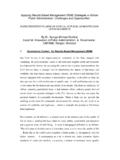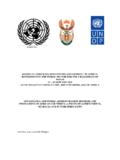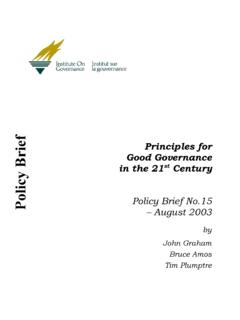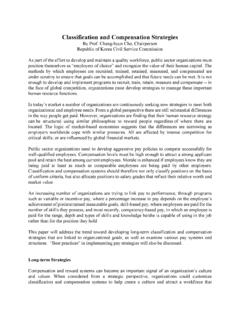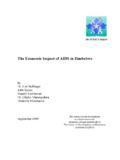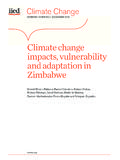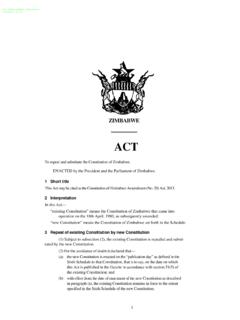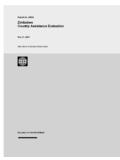Transcription of Public Administration Country Profile - United …
1 All papers, statistics and materials contained in the Country Profiles express entirely the opinion of the mentioned authors. They should not, unless otherwise mentioned, be attributed to the Secretariat of the United Nations. The designations employed and the presentation of material on maps in the Country Profiles do not imply the expression of any opinion whatsoever on the part of the Secretariat of the United Nations concerning the legal status of any Country , territory, city or area or of its authorities, or concerning the delimitation of its frontiers or boundaries. RREEPPUUBBLLIICC OOFF ZZIIMMBBAABBWWEE PPuubblliicc AAddmmiinniissttrraattiioonn CCoouunnttrryy PPrrooffiillee Division for Public Administration and Development Management (DPADM) Department of Economic and Social Affairs (DESA) United Nations Contributions: African Training and Research Centre in Administration for Development (CAFRAD) July 2004 Table of Contents Table of 1. General Information.
2 3 Economy ..3 Public Public Sector Employment and 2. Legal Legislative Executive Judiciary Branch ..6 Local 3. The State and Civil Civil 4. Public Service ..8 Legal 5. Ethics and Civil Corruption ..11 6. e-Government e-Participation ..14 7. National Miscellaneous 1 zimbabwe Click here for detailed map Source: The World Factbook - zimbabwe Government type Republic Independence 18 April 1980 (from UK) Constitution 21 December 1979 (click here) Legal system Mixture of Roman-Dutch and English common law Administrative divisions 8 provinces and 2 cities with provincial status (Bulawayo & Harare) Source: The World Factbook - zimbabwe In elections in February 1980, Robert Mugabe's ZANU-Patriotic Front (ZANU-PF) party won 57 of the 80 'common roll' seats and Joshua Nkomo's Patriotic Front (effectively ZAPU) party won 20 seats. The Rhodesia Front won all 20 seats reserved for the white minority.
3 Robert Mugabe became Prime Minister, leading a coalition government. The Matabeleland Insurgency (1983-87) following Nkomo's dismissal from government office in 1982 was brought to an end with the unity agreement between ZANU-PF and ZAPU in 1987. Constitutional changes in 1987 ended reserved seats for whites and created an executive Presidency, replacing the ceremonial post of President and incorporating the post of Prime Minister. Mugabe became zimbabwe 's first executive President at the end of 1987. The Movement for Democratic Change (MDC) was formed in September 1999 under the leadership of Morgan Tsvangirai, The Country 's gross domestic product (GDP) dropped 14 percent to an estimated US$ billion in 2003, a decline of percent. Unemployment surpassed 70 percent. By December 2003, inflation reached percent, Source: Immigration and Nationality Directorate (UK) - zimbabwe Country Report (4/2004) 2 ZZIIMMBBAABBWWEE GGeenneerraall IInnffoorrmmaattiioonn People zimbabwe Botswana Zambia 1 Population a Total estimated population (,000), 2003 12,892 1,785 10,812 Female estimated population (,000), 2003 6,487 909 5,438 Male estimated population (,000), 2003 6,405 876 5,374 Sex ratio (males per 100 females), 2003 99 96 99 Average annual rate of change of pop.
4 (%), 2000-2005 Youth and Elderly Population b Total population under age 15 (%), 2003 43 40 47 Female population aged 60+ (%), 2003 6 5 5 Male population aged 60+ (%), 2003 5 4 4 Human Settlements c Urban population (%), 2001 36 49 40 Rural population (%), 2001 64 51 60 Urban average annual rate of change in pop. (%), 00- 05 Rural average annual rate of change in pop/ (%), 00- 05 Education d Total school life expectancy, 2000/2001 1 Female school life expectancy, 2000/2001 1 Male school life expectancy, 2000/2001 1 Female estimated adult (15+) illiteracy rate (%), 2000 2 Male estimated adult (15+) illiteracy rate (%), 2000 2 Employment e Unemployment rate (15+) (%), 2000 .. 1 Female adult (+15) economic activity rate (%), 1999 65 48v .. 2 Male adult (+15) economic activity rate (%), 1999 79 70v .. 2 Notes: i 1992; ii 1991; iii 1990; iv Ages 12 years and over, Year beginning in August of year indicated; v 1998 Economy zimbabwe Botswana Zambia 2 GDP a GDP total (millions US$), 2002 8,304 5,188 3,683 GDP per capita (US$), 2002 640 3,030 352 PPP GDP total (millions int.)
5 US$), 2002 29,768i 14,112 8,431 PPP GDP per capita(int. US$), 2002 2,296i 8,243 806 Sectors b Value added in agriculture (% of GDP), 2004 Value added in industry (% of GDP), 2004 Value added in services (% of GDP), 2004 Miscellaneous c GDP implicit price deflator (annual % growth), 2003 Private consumption (% of GDP), 2003 Government consumption (% of GDP), 2003 Notes: i Figures for 2001 or 2000; ii 2000 1 United Nations Statistics Division: a Statistics Division and Population Division of the UN Secretariat; b Statistics Division and Population Division of the UN Secretariat; c Population Division of the UN Secretariat; d1 UNESCO ; d2 UNESCO; e1 ILO; e2 ILO/OECD2 World Bank - Data and Statistics: 3a Quick Reference Tables; b Data Profile Tables.
6 C Country at a Public Spending zimbabwe Botswana Zambia Public expenditures 3 Education (% of GNP), 1985-1987 a Education (% of GNP), 1995-1997 a Health (% of GDP), 1990 Health (% of GDP), 1998 3ii Military (% of GDP), 1990 b Military (% of GDP), 2000 b Total debt service (% of GDP), 1990 Total debt service (% of GDP), 2000 Notes: i Data refer to a year or period other than that specified; ii 1999 Public Sector Employment and Wages Data from the latest year available zimbabwe 1991-1995 zimbabwe 1996-2000 Sub-Saharan Africa average4 1996-2000 Non-Franco-phone Africa average4 1996-2000 Middle income group average4 1996-2000 Employment (,000) .. Civilian Central Government5 (% pop.) .. (,000) .. Sub-national Government5 (% pop.)
7 (,000) .. Education employees (% pop.) .. (,000) .. Health employees (% pop.) .. (,000) .. Police (% pop.) .. (,000) Armed forces (% pop.) (,000) .. SOE Employees (% pop.) .. (,000) .. Total Public Employment (% pop.) .. Wages Total Central gov't wage bill (% of GDP) Total Central gov t wage bill (% of exp) Average gov't wage (,000 LCU) .. Real ave. gov t wage ('97 price) (,000 LCU) .. Average gov t wage to per capita GDP ratio .. Source: World Bank - Public Sector Employment and Wages 3 UNDP - Human Development Report 2002a Data refer to total Public expenditure on education, including current and capital expenditures.
8 B As a result of a number of limitations in the data, comparisons of military expenditure data over time and across countries should be made with caution. For detailed notes on the data see SIPRI (2001). 4 Averages for regions and sub regions are only generated if data is available for at least 35% of the countries in that region or sub region. 45 Excluding education, health and police if available (view Country Sources for further explanations). LLeeggaall SSttrruuccttuurree The Independence Constitution signed at the Lancaster House Conference in 1979, together with 16 amendments, is the fundamental law which determines zimbabwe s governmental structure. A new constitution proposal was rejected by the electorate in the February 2000 referendum. The Constitution provides for three arms of government, namely the Legislature, Executive, and the Judiciary. Source: zimbabwe Mission to the United Nations - Government (edited) Legislative Branch Unicameral House of Assembly (150 seats - 120 elected by popular vote for five-year terms, 12 nominated by the president, 10 occupied by traditional chiefs chosen by their peers, and 8 occupied by provincial governors appointed by the president).
9 6 women in parliament: 15 out of 150 seats: (10%).7 The legislative authority of zimbabwe is vested in the Legislature which consists of the President and Parliament. The Parliament consists of one hundred and fifty members (150) qualified in accordance with Schedule 3 for election or appointment to Parliament One hundred and twenty (120) are elected by voters registered on the common roll for one hundred and twenty common roll constituencies; and Twelve (12) are appointed by the President; and Ten (10) are chiefs elected in accordance with the Electoral Law; and Eight (8) are Provincial Governors, appointed by the President as members of Parliament ex officio. The President may at any time dissolve Parliament. Parliament, unless sooner dissolved, shall continue for five years. Parliament may, by resolution supported by the votes of not less than two-thirds of all its members, pass a vote of no confidence in the Government. The power of Parliament to make laws is exercised by Bills passed by Parliament and assented to by the President.
10 Source: Constitution of the Republic of zimbabwe Executive Branch cabinet: Cabinet appointed by the president; responsible to the House of Assembly elections: Presidential candidates nominated with a nomination paper signed by at least 10 registered voters (at least one from each province) and elected by popular vote; election; co-vice presidents appointed by the president The executive authority of zimbabwe is vested in the President. The President is Head of State and Head of Government. The President is elected for a six-year term 6 Source of fact boxes if nothing else stated: The World Factbook - Zimbabwe7 Inter-Parliamentary Union - Women in National Parliaments 5 Fact box: elections: Last held 24-25 June 2000 (next to be held 2005) election results: Percent of vote by party - ZANU-PF , MDC , other ; seats by party - ZANU-PF 62, MDC 57, ZANU-Ndonga 1 by all the registered voters, and may be re-elected for any number of further The President must be a citizen of zimbabwe by birth or by descent, 40 years of age, and a resident in zimbabwe .
